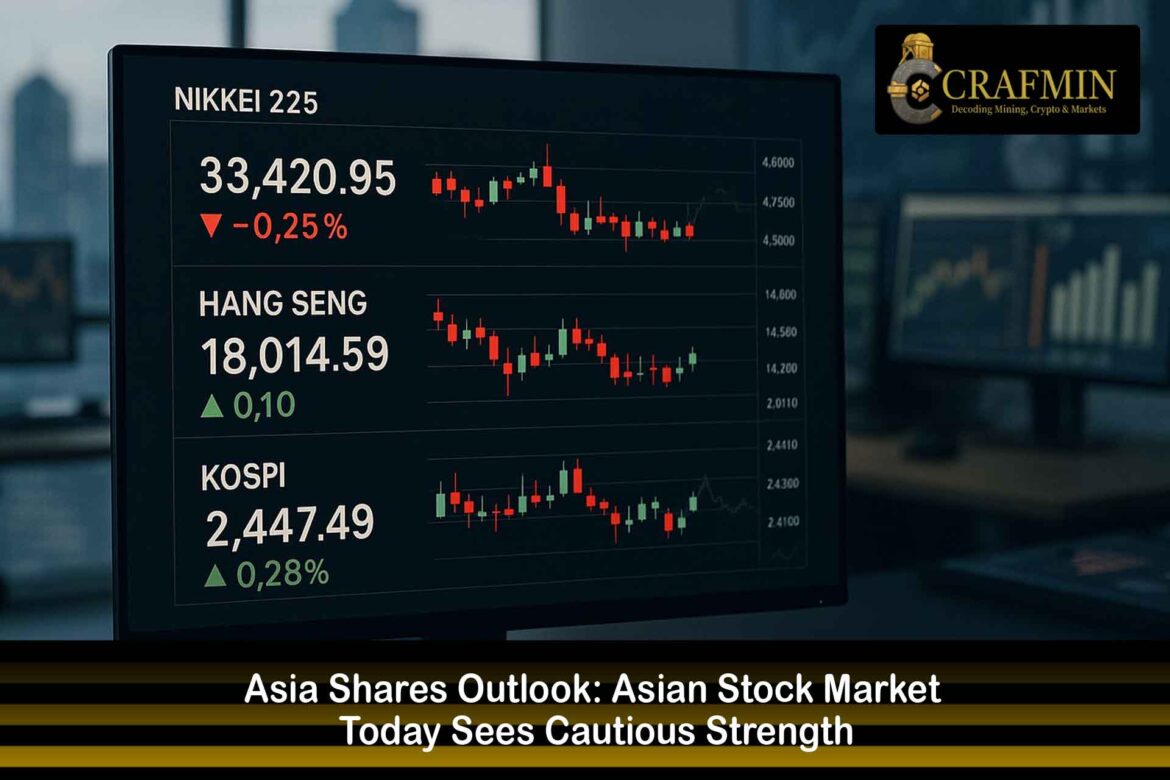All the markets in Asia are steady and gaining at the beginning of the week, the main driving forces being an influx of hope about U.S. rate cuts and the revival of the technology sector. With almost a hundred per cent certainty, investors are counting on the Federal Reserve’s possible selective sifting of their monetary policy, which is accordingly enhancing the regional risk-taking.
On the other hand, the positive attitude has been further strengthened by the rumour of Nvidia’s AI chip sales to China being first and finally greenlighted, which has consequently restored the trust of tech investors.

Asian markets steady, boosted by Fed rate-cut hopes and tech revival.
Why Are Tech Stocks Rallying Again?
The revival of technology is the key factor that works in favour of the larger market. The continued encouragement comes from the recent hefty stock performance of the AI-linked firms and the hope that the government’s restrictions on certain chip exports will be completely lifted.
This alteration gives a go-ahead to the traders who had previously grown cautious with valuations in the tech market being too high. Simultaneously, the semiconductor and chip producers are thriving as the market forecasts a significant demand increase for AI-related products.
What Risks Could Stall The Upside?
Nonetheless, the cheerful mood is not without a few obstacles to overcome. The timing and extent of any Fed rate cuts are still shrouded in a high degree of uncertainty, and should the Bank not meet market expectations, there is a risk of a sharp negative reaction from the latter.
There are still, for instance, doubts about valuations in technology, especially in the area of artificial intelligence stocks, which, should they be the case, would adversely affect the general market accessibility via the overspill of disheartenment. Moreover, economic reports from key Asian markets like China are still sending mixed signals, thus slowing down the rally.

Uncertain Fed cuts risk market disappointment and possible sharp corrections.
Regional Dynamics Are Mixed Across Asia
The strength is regional but not uniform. In technology and export-oriented shares, Japan, South Korea, and Taiwan are gaining ground. However, mainland China’s and Hong Kong’s markets are quieter, mirroring worries about the economy as well as the direction of government policies.
Australia shares the increase in global market sentiment but is still affected by its own macroeconomic issues, which influence investor behaviour. This divergence is an indicator of how differently the Asian markets are reviving their business.
Short-Term Outlook Shows Moderate Upside
The Asia shares outlook is leaning cautiously positive because of the improved risk sentiment and expectations for rate cuts. If the current rate-cut projections are followed through and the technology sector continues to report good earnings, then the stock market in Asia can keep on moving up gradually.
Nevertheless, the journey might not be smooth because of investors being attentive to the dangers of inflation, the risks of valuations, or geopolitical surprises. Being selective about investments is likely to play a big part, as the gains might not be widespread.

Asia shares outlook positive as rate cuts and tech earnings support.
Long-Term Implications For the Stock Market Asia 2025
The Asian stock market forecast for 2025, considering factors like the AI boom, chip-making dominance, and regulations to support the industry, is very positive. If the central banks go ahead with the easing of money and the economies in the region improve, the shares of quality tech and exports may continue to lead.
On the other hand, any policy miscalculation, trade conflict, or economic slowdown could wipe out these gains. For investors, a balanced strategy that centres on premium firms along with disciplined risk management seems to be the way to go.
How Do Foreign Fund Flows Impact The Rally?
Foreign fund flows are considered to be a major factor in deciding the short-term market direction of Asia. A number of regional exchanges are now experiencing inflows again as global investors are shifting their priorities from the sluggish Western markets.
However, these flows are still subject to the changes of bond yields and currencies. An abrupt increase in the U.S. yields could quickly turn around the current trend. This situation makes foreign investors a significant factor in the Asia shares forecast.

Foreign inflows guide short-term Asian markets as investors shift regions.
Why Are Currency Movements Influencing Asian Equities?
Today’s Asian stock market is very much under the influence of the currency trends. A weaker US dollar has been a great help for the emerging Asian currencies, which in turn has made the regional equities more appealing to the overseas investors.
Concurrently, the commodity-linked currencies like the Australian dollar are responding to the shifting global demand signals from China. These movements are playing an important role in determining the performance of different sectors among various Asian markets.
How Are Commodities Affecting Market Sentiment?
Follow the commodity trends, and you will see the corresponding broad investor confidence in the region. After the recent volatility, oil prices have been stabilised, which resulted in a reduction of cost pressure on the economies of Asia that depend on imports.
On the other hand, industrial metals are taking different paths owing to the uncertainty of Chinese demand. These developments are indicative of the macro conditions being fragile despite the increasing equity sentiment in the Asia 2025 stock market narrative.
Also Read: Dow Jones Stock Markets Reel as Bond Yields Rattle Global Sentiment
FAQs
Q: What is the current Asia shares outlook?
A: The outlook is cautiously optimistic, with rate-cut hopes and the strength of AI-linked tech stocks holding the ground.
Q: Which drivers are backing the current rally in the Asian stock market today?
A: Major drivers are U.S. rate cut expectations, possible lessening of chip export restrictions, and very positive tech sentiment.
Q: What could derail this positive momentum?
A: Risks are poorly timed Fed action, AI stocks too pricey, and poor macro data in the major Asian economies.
Q: How should investors approach the stock market in Asia in 2025?
A: Investors should concentrate on the quality of the tech and export companies, and at the same time weigh the upsides against the risks.

